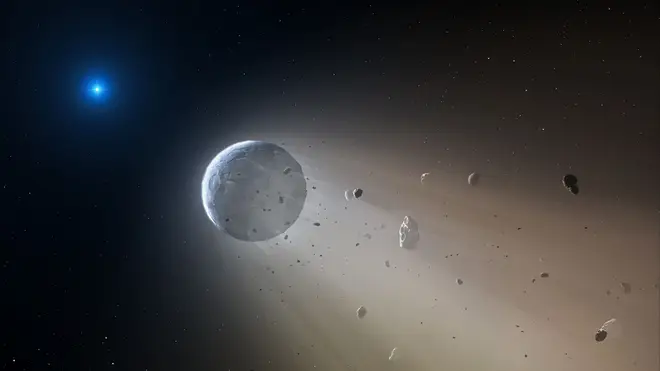
Ali Miraj 12pm - 3pm
4 December 2019, 22:59

Scientists have discovered a giant planet orbiting around a dead white dwarf star roughly 2,000 light years from Earth.
The revelation was made possible by astronomers, who found evidence of a disc of gas created from the distant planet's evaporating atmosphere.
Its size is similar to that of Neptune and is more than four times as large as the Earth-sized white dwarf it orbits.
Researchers believe its distance from our home planet is roughly 2,000 light years, which is more than 476 times the distance of the nearest star to our Sun.
Professor of Public Understanding of Science at the University of Brighton, Hal Sosabowski, told LBC News the planet offers us a glimpse at the potential future of our own solar system.
"In six billion years our Sun will run out of hydrogen and will start to burn helium instead, causing it to swell in size until that too runs out.
"It will then contract to a white dwarf, like we have seen with the star in question.
"But somehow this newly-discovered planet has survived."

The revelation is the first of its kind as, before now, no other planet had been found to have lived through a star's transition to a white dwarf.
It would take more than 76.5 million years to travel to the distant celestial object if travelling in The Space Shuttle, which had a maximum speed of 17,500 miles per hour, Professor Hal confirmed.
The giant planet takes just 10 days to orbit the star and it leaves a trail of gas comprised of hydrogen, oxygen and sulfur.
Astronomers from the University of Warwick's Department of Physics and the Millennium Nucleus for Planet Formation at the University of Valparaiso published their finding in the journal Nature.
The star, named WDJ0914+1914, was identified in a survey of 10,000 white dwarfs observed by the Sloan Digital Sky Survey.
Professor Hal explained to LBC News that Earth would be unlikely to survive if the same thing happened to our own Sun.
"If you look at the long-term future, then you need to find a strategy for saving the human race and we will need to find somewhere else to live," he said.
"Unfortunately we're not special. We live on an average star in the back water of the Milky Way and we will suffer the same fate in six billion years."

Lead author Dr Boris Gaensicke, from the University of Warwick, said: "At first, we thought that this was a binary star . . . however, our observations show that it is a single white dwarf with a disc around it roughly 10 times the size of our sun.
"Such a system has never been seen before, and it was immediately clear to me that this was a unique star."
Dr Matthias Schreiber from the University of Valparaiso calculated that the 28,000 °C hot white dwarf is slowly evaporating the hidden icy giant by bombarding it with high energy photons.
Dr Gaensicke said: "This star has a planet that we can't see directly, but because the star is so hot it is evaporating the planet, and we detect the atmosphere it is losing.
"There could be many cooler white dwarfs that have planets but lacking the high-energy photons necessary to drive evaporation, so we wouldn't be able to find them with the same method.
"This discovery is major progress because over the past two decades we had growing evidence that planetary systems survive into the white dwarf stage."